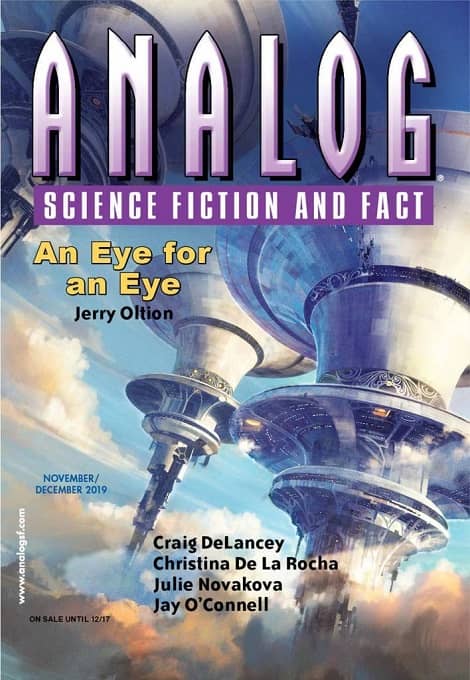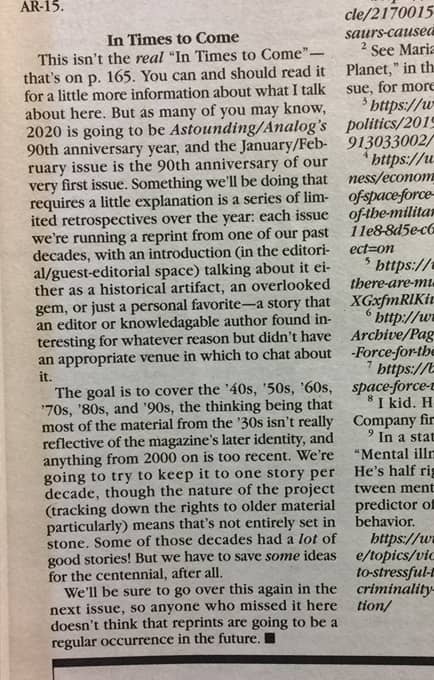Analog Announces 90th Anniversary Reprint Series
 |
 |
Analog Science Fiction and Fact, November-December 2019, and an excerpt from Trevor Quachri’s editorial
Gabe Dybing, who clearly gets his issues of Analog faster than I do, tipped me off that editor Trevor Quachri has something very interesting planned for the magazine’s upcoming 90th Anniversary year (90! Holy cats). Gabe sent me the above pic of Trevor’s editorial in the November-December issue, on sale this week. For those of you who don’t like to squint, here’s the relevant text.
As many of you may know, 2020 is going to be Astounding/Analog’s 90th anniversary year, and the January/February issue is the 90th anniversary of our very first issue. Something we’ll be doing that requires a little explanation is a series of limited retrospectives over the year: each issue we’re running a reprint from one of our past decades, with an introduction (in the editorial/guest-editorial space) talking about it either as a historical artifact, an overlooked gem, or just a personal favorite — a story that an editor or knowledagable (sic) author found interesting for whatever reason but didn’t have an appropriate venue in which to chat about it.
The goal is to cover the ’40s, ’50s, ’60s, ’70s, ’80s, and ’90s, the thinking being that most of the material from the ’30s isn’t really reflective of the magazine’s later identity, and anything from 2000 on is too recent. We’re going to try to keep it to one story per decade, though the nature of the project (tracking down the rights to older material particularly) means that’s not entirely set in stone. Some of those decades had a lot of good stories! But we have to save some ideas for the centennial, after all.
This is great news for classic SF fans, and I look forward to seeing what Trevor chooses (and I hope some bright-eyed new readers will discover a few giants of the genre as a result).
But since I’m old, I also have to grouse a little… Trevor can’t find one pulp story from the 1930s worth a look?? In the 1930s, John W. Campbell and Astounding published stellar fiction by the best pulp writers of the era — including “Who Goes There?” by John W. Campbell, Jr, “Helen O’Loy” by Lester del Rey, “Black Destroyer” by A. E. van Vogt, “Life-Line” by Robert A. Heinlein, “Ether Breather” by Theodore Sturgeon, and many, many more. Maybe Trevor is just looking for suggestions. Shout yours out in the Comments.
Hell, “farewell to the Master” by Harry Bates, the founding editor and the source story for THE DAY THE EARTH STOOD STILL.
To say nothing of Campbell’s “Twilight” and not a few others. Tremaine laid some groundwork for Campbell, who started in 1937…
I think the idea is to feature one old story per issue, and since there are only six issues in the year, there are too many decades to feature them all.
One assumes that only short works would be considered (otherwise there would probably be complaints about the oldies taking up too much space, so no “Sidewise in Time” or “Proxima Centauri” by Murray Leinster). Of those not yet mentioned, “Old Faithful”, by Raymond Z. Gallun is my favorite.
> Hell, “farewell to the Master” by Harry Bates… To say nothing of Campbell’s “Twilight” and not a few others.
Todd,
“Farewell to the Master” is a fine choice! And I was tempted to pick a few other Campbell tales, but I figured “Who Goes There?” was enough to make my point. 🙂
> I think the idea is to feature one old story per issue, and since there are only six issues in the year, there are too many decades to feature them all.
Dolphin,
Ooof. You know, you’re absolutely right. I should have thought of that.
If Trevor can only pick 6 decades of ASTOUNDING, then that’s a tough call. I hate to see the pulp era unfairly overlooked, but it makes sense to feature work that will resonate more strongly with modern readers.
> One assumes that only short works would be considered
Tsk. I hope not. Lots of great novellas to consider.
What this really needs to be is an anthology, but I understand that’s not the point of the thing. One wonders if the current generation of readers, whomever they may be, will even care about “the old stuff”.
>One wonders if the current generation of readers, whomever they may be, will even care about “the old stuff”.
I sometimes wonder who is the readership of both Analog and Asimov’s, often assuming that I myself (at 44 years old) is this “new readership.” For many years I have been a subscriber to Asimov’s, only within the last year or so picking up Analog out of a newfound mind-blowing wonder regarding “hard” scifi.
In Asimov’s James Patrick Kelly said circulation had gone down, but this was a measure of only print copies. He made an unconfirmed conjecture that electronic readership might have gone up—though this might not represent “new readership” but some format changeover.
I have print subscriptions because I prefer to share material that I think would be of interest to friends.
Gabe,
I hate to say it but I suspect you’re right that, at 44, you’re one of the new readership.
When I started reading SF in the 70s the magazines were still the heart of the genre, where are the new writers appeared first, everyone got their news, and we all read the same editorials and Spider Robinson’s review columns in ANALOG. I started picking up the magazines at age 12 and 13 because everyone was talking about them (meaning at conventions, but also in book introductions and other places I looked to teach me how to plug into the genre.) I vividly remember how excited I was to find magazines like STARLOG and LOCUS, and how I looked forward to them every month.
Magazines aren’t really part of the discussion anymore. Young readers certainly don’t seem to be discovering them the same way, anyway.